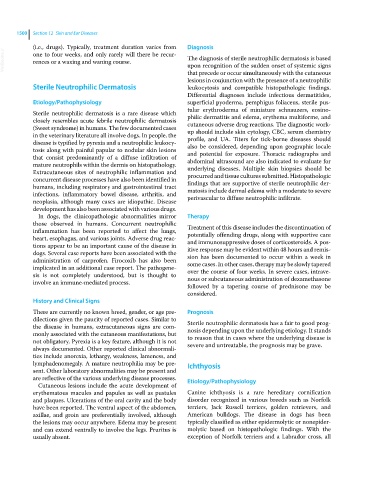Page 1562 - Clinical Small Animal Internal Medicine
P. 1562
1500 Section 12 Skin and Ear Diseases
(i.e., drugs). Typically, treatment duration varies from Diagnosis
VetBooks.ir one to four weeks, and only rarely will there be recur- The diagnosis of sterile neutrophilic dermatosis is based
rences or a waxing and waning course.
upon recognition of the sudden onset of systemic signs
that precede or occur simultaneously with the cutaneous
lesions in conjunction with the presence of a neutrophilic
Sterile Neutrophilic Dermatosis leukocytosis and compatible histopathologic findings.
Differential diagnoses include infectious dermatitides,
Etiology/Pathophysiology superficial pyoderma, pemphigus foliaceus, sterile pus-
tular erythroderma of miniature schnauzers, eosino-
Sterile neutrophilic dermatosis is a rare disease which philic dermatitis and edema, erythema multiforme, and
closely resembles acute febrile neutrophilic dermatosis cutaneous adverse drug reactions. The diagnostic work‐
(Sweet syndrome) in humans. The few documented cases up should include skin cytology, CBC, serum chemistry
in the veterinary literature all involve dogs. In people, the profile, and UA. Titers for tick‐borne diseases should
disease is typified by pyrexia and a neutrophilic leukocy- also be considered, depending upon geographic locale
tosis along with painful papular to nodular skin lesions and potential for exposure. Thoracic radiographs and
that consist predominantly of a diffuse infiltration of abdominal ultrasound are also indicated to evaluate for
mature neutrophils within the dermis on histopathology. underlying diseases. Multiple skin biopsies should be
Extracutaneous sites of neutrophilic inflammation and procurred and tissue cultures submitted. Histopathologic
concurrent disease processes have also been identified in findings that are supportive of sterile neutrophilic der-
humans, including respiratory and gastrointestinal tract matosis include dermal edema with a moderate to severe
infections, inflammatory bowel disease, arthritis, and perivascular to diffuse neutrophilic infiltrate.
neoplasia, although many cases are idiopathic. Disease
development has also been associated with various drugs.
In dogs, the clinicopathologic abnormalities mirror Therapy
those observed in humans. Concurrent neutrophilic Treatment of this disease includes the discontinuation of
inflammation has been reported to affect the lungs, potentially offending drugs, along with supportive care
heart, esophagus, and various joints. Adverse drug reac- and immunosuppressive doses of corticosteroids. A pos-
tions appear to be an important cause of the disease in itive response may be evident within 48 hours and remis-
dogs. Several case reports have been associated with the sion has been documented to occur within a week in
administration of carprofen. Firocoxib has also been some cases. In other cases, therapy may be slowly tapered
implicated in an additional case report. The pathogene- over the course of four weeks. In severe cases, intrave-
sis is not completely understood, but is thought to nous or subcutaneous administration of dexamethasone
involve an immune‐mediated process.
followed by a tapering course of prednisone may be
considered.
History and Clinical Signs
There are currently no known breed, gender, or age pre- Prognosis
dilections given the paucity of reported cases. Similar to Sterile neutrophilic dermatosis has a fair to good prog-
the disease in humans, extracutaneous signs are com- nosis depending upon the underlying etiology. It stands
monly associated with the cutaneous manifestations, but to reason that in cases where the underlying disease is
not obligatory. Pyrexia is a key feature, although it is not severe and untreatable, the prognosis may be grave.
always documented. Other reported clinical abnormali-
ties include anorexia, lethargy, weakness, lameness, and
lymphadenomegaly. A mature neutrophilia may be pre- Ichthyosis
sent. Other laboratory abnormalities may be present and
are reflective of the various underlying disease processes. Etiology/Pathophysiology
Cutaneous lesions include the acute development of
erythematous macules and papules as well as pustules Canine ichthyosis is a rare hereditary cornification
and plaques. Ulcerations of the oral cavity and the body disorder recognized in various breeds such as Norfolk
have been reported. The ventral aspect of the abdomen, terriers, Jack Russell terriers, golden retrievers, and
axillae, and groin are preferentially involved, although American bulldogs. The disease in dogs has been
the lesions may occur anywhere. Edema may be present typically classified as either epidermolytic or nonepider-
and can extend ventrally to involve the legs. Pruritus is molytic based on histopathologic findings. With the
usually absent. exception of Norfolk terriers and a Labrador cross, all

